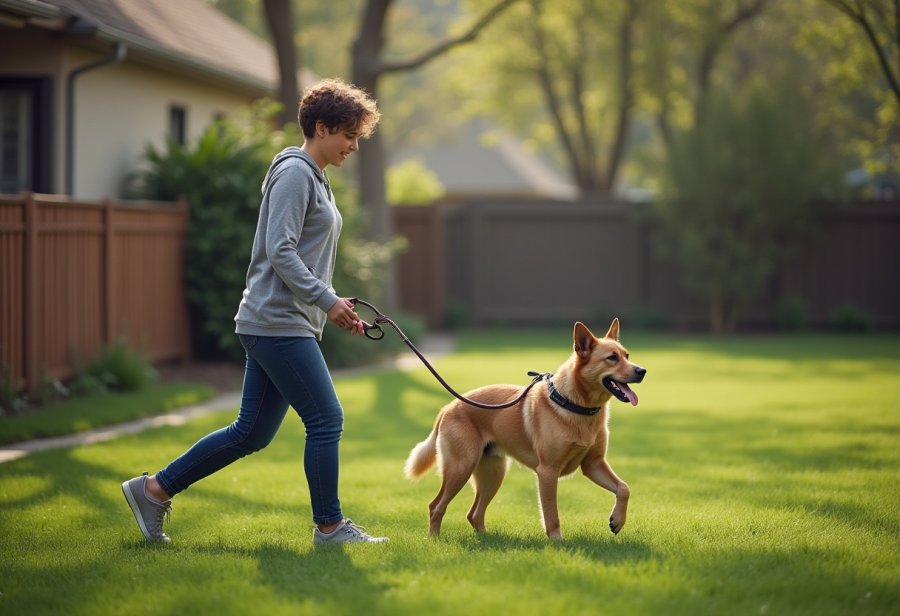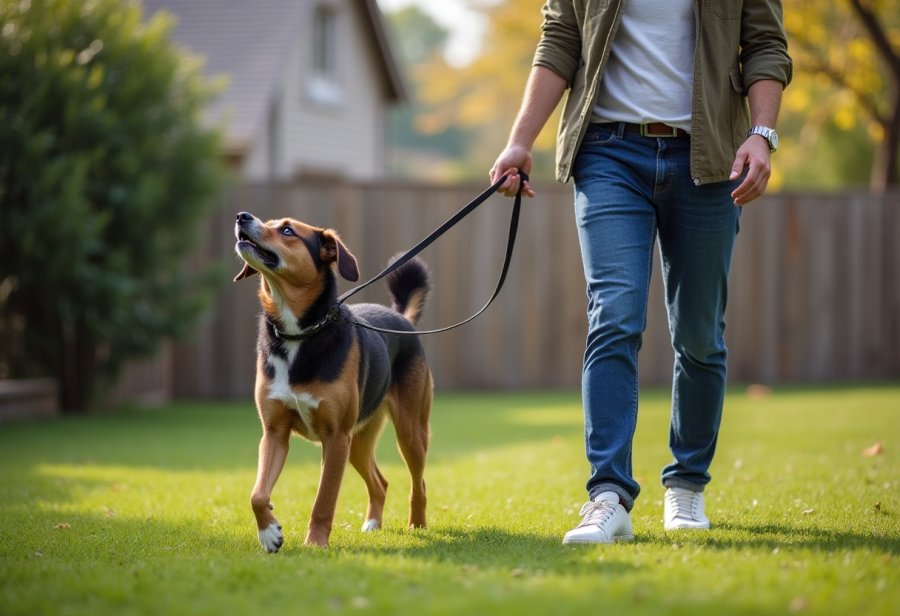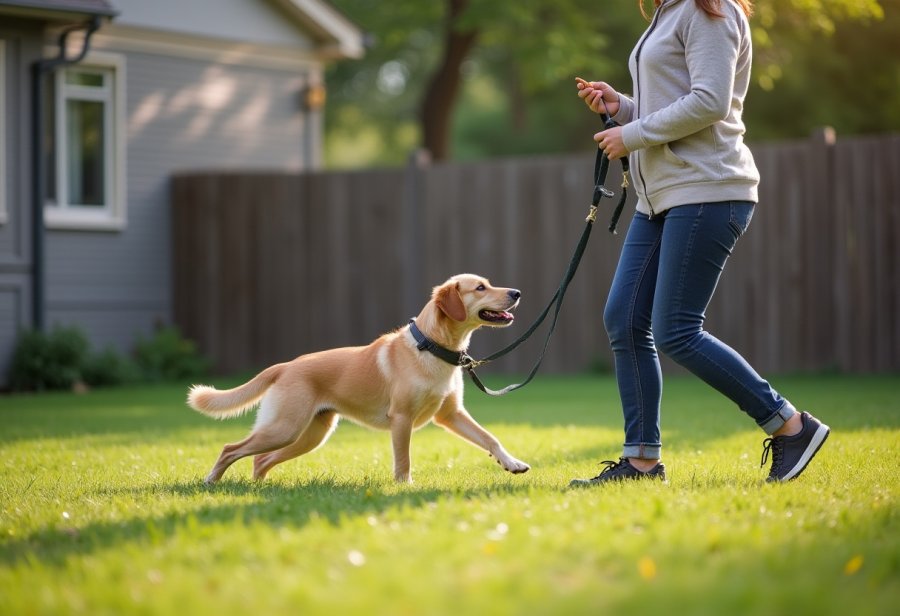
Imagine transforming daily walks from chaotic pulls and distractions into moments of mutual trust and calm connection. Mastering the art of walking calmly with your dog isn’t just about obedience—it’s about forging a deeper bond rooted in patience, understanding, and positive reinforcement. This guide reveals how consistent routines, gentle redirection, and rewarding good behavior can turn frustrating outings into peaceful rituals. But what happens when external distractions, anxiety, or stubbornness threaten progress? The journey requires patience and adaptability, gradually building your dog’s confidence and focus amidst challenges. Are you ready to unlock a harmonious partnership where every step fosters trust and joy? With steady effort, you’ll discover that calm walks not only improve your pet’s behavior but also create shared moments of connection that strengthen your relationship, making routine outings a source of tranquility and trust.

Transform Your Walks: Building Trust and Harmony Through Calm Dog Walking
Mastering calm dog walking goes beyond teaching your pet to stay by your side; it lays the groundwork for a relationship built on trust and mutual respect. When your dog learns to walk peacefully, what might otherwise be a source of stress or frustration becomes a shared opportunity for connection. A calm walk fosters relaxation for both of you, reducing pulling, lunging, and anxiety, and transforming routine outings into moments of harmony.
The benefits extend far beyond good manners. Calm leash walking deepens your understanding of each other and enhances your dog’s responsiveness to cues. When your dog feels secure and untroubled, they become more attentive and eager to follow your guidance. This sense of trust makes walks more enjoyable and strengthens your bond, creating a partnership rooted in confidence and calm.
Building this level of composure also helps prevent common behavioral issues like leash reactivity or overexcitement. It creates a safe environment where your dog can explore without becoming overwhelmed, making outings smoother and more predictable. As your dog learns that staying calm and close results in positive experiences, they develop a sense of security that encourages cooperation and trust.
This journey toward peaceful walks requires patience and consistency, but the rewards are worth it. When both of you approach walks with calmness, the experience becomes a shared ritual of trust and connection. Over time, these moments of harmony become an integral part of your daily routine, enriching your relationship and making every outing a testament to your teamwork and understanding.
Foundations of Calm Dog Walking: Core Principles and Understanding
Before you start training your dog to walk calmly, understanding some core principles about canine behavior is essential. Dogs are naturally curious and easily distracted, which can make staying focused on walks a challenge. Building trust and clear communication helps your dog feel safe and motivated to pay attention. Recognizing what motivates your dog—whether treats, praise, or play—allows you to reinforce good behavior effectively. Tailoring your approach to your dog’s personality and energy level makes training smoother and more enjoyable.
It’s also important to see your dog’s pulling or sniffing not as stubbornness but as instinct-driven behaviors rooted in their natural curiosity. Exploring through nose and ears is how dogs learn about their environment. Viewing these actions as normal helps you approach training with patience, rather than frustration. Creating a bond based on positive experiences and consistent cues encourages your dog to trust you and remain calm during walks.
Trust forms the foundation of calm leash walking. When your dog feels confident that you’ll keep them safe and guide them gently, they’re more likely to relax. This trust deepens through praise, treats, and respecting your dog’s signals. A strong bond makes it easier for your dog to follow commands like “heel” and stay attentive, transforming walks into peaceful, cooperative routines.
Choosing the right environment and equipment also sets the stage for success. Start training in quiet, familiar spaces free of distractions. Use comfortable, well-fitting collars or harnesses and a sturdy leash that give you control without causing discomfort. Keep treats and toys handy for positive reinforcement, helping your dog associate walks with enjoyable, calm experiences from the outset.
Laying this groundwork of understanding and trust makes training more effective. When you approach your dog’s behavior with empathy and consistency, calm leash walking becomes a shared goal rather than a struggle. This solid foundation supports your journey toward peaceful, confident walks—building a bond rooted in mutual respect and harmony.
Step-by-Step Training Techniques for Peaceful Walks
Teaching your dog to walk calmly at your side begins with clear, consistent cues and positive reinforcement. Start in a quiet space, introducing the ‘heel’ command by holding treats close to your dog’s nose to encourage them to stay beside you, usually on your left. When your dog walks without pulling or lagging, immediately praise and reward with a treat. Keep training sessions brief—around five minutes—to maintain focus and prevent frustration. As your dog improves, gradually increase the distance and introduce mild distractions to challenge their focus.
Next, focus on maintaining your dog’s attention despite environmental distractions. Use cues like “look at me” or “focus,” rewarding when your dog makes eye contact or responds correctly. Practice indoors first, then step outside into busier settings. High-value treats are essential here—reward generously when your dog responds, boosting confidence and attentiveness. Consistent leash handling also matters; guide gently back to your side if they surge ahead, avoiding pulling or yanking, which can create tension and resistance. Redirect and praise calm behavior instead.
Incorporate regular breaks into your walks. When your dog walks calmly, pause briefly to praise and reward, reinforcing relaxation. These moments teach your dog that calmness results in positive outcomes, encouraging them to stay focused for longer periods. Use gentle guidance to redirect attention if they become distracted, and always respond with a calm, encouraging tone. Over time, these small cues and rewards will solidify good habits and make calm walking a natural routine.
Consistency and patience are crucial. Reinforce the desired behavior immediately—whether it’s walking beside you, responding to cues, or remaining calm amid distractions. If setbacks occur, revert to simpler exercises or familiar environments to rebuild confidence. Remember, progress often happens in waves, so celebrate small victories like a few minutes of focused walking. This steady approach fosters trust and helps your dog associate calmness with positive experiences.
Positive reinforcement anchors your training. Use treats, praise, or favorite toys to reward good behavior instantly. This immediate feedback creates a strong link between calm walking and positive outcomes, making these habits more likely to stick. Avoid punishment or harsh corrections, which can undermine trust and cause anxiety. With patience, consistency, and encouragement, your dog will learn to walk peacefully by your side, turning everyday outings into moments of shared trust and harmony.
By incorporating these techniques consistently, you’ll see your dog’s walking behavior improve steadily. For additional tips on reinforcing calmness and focus during walks, consider exploring more about dog training resources. This can provide valuable insights to help you achieve peaceful walks and strengthen your bond.

Seamlessly Incorporate Calm Walking into Daily Routines
Incorporating calm walking techniques into your daily routine helps turn training into lasting habits. Consistency is key; set specific times each day for walks so your dog can anticipate and settle into a calm mindset. Starting with short, relaxed outings and gradually increasing their length builds your dog’s confidence and focus, making calm behavior more natural over time. Using the same cues like “heel” or “focus” during each walk reinforces expectations and creates a sense of routine your dog can rely on.
Keep your walks positive and frustration-free. When your dog pulls or becomes distracted, pause gently and redirect their attention without raising your voice or pulling back harshly. Pausing until they return to your side teaches patience and shows that staying close pays off. Reinforcing calmness with praise and treats during these moments helps your dog associate relaxed walking with good experiences, gradually making calmness their default state.
Varying your routes and environments introduces new challenges and opportunities to practice focus. Start in quiet neighborhoods or familiar parks, then gradually explore busier streets or crowded areas. Carry treats or favorite toys to reward your dog for good focus, regardless of the setting. If your dog becomes overly excited or pulls, stop and redirect calmly, maintaining a steady tone. Over time, these small, consistent efforts help your dog generalize calm behavior across different situations, making peaceful walks a regular part of your life.
Integrate these techniques into every outing, whether it’s a quick trip to the store or a leisurely walk around the block. Use calm commands and positive reinforcement consistently to reinforce good habits. Maintaining a relaxed, confident attitude encourages your dog to mirror your calmness, making each walk a shared experience of trust. As routines become familiar, calm walks will feel effortless, strengthening your bond and making outings more enjoyable for both of you.
Remember to be patient and adaptable. Not every walk will go perfectly, and setbacks are normal. When your dog pulls or gets distracted, respond with gentle redirection and praise. Focus on small successes, like a few minutes of focused walking, and celebrate these moments. Over time, these small wins accumulate, building your dog’s confidence and your relationship. With steady effort, peaceful, bond-building walks become a natural and rewarding part of your daily life.
Sustaining Calmness and Trust for Long-Term Success
Maintaining calmness and trust during walks over time relies on consistency and positive reinforcement. Dogs thrive on routines, so sticking to regular walk schedules and familiar routes helps them feel secure and understand what to expect. When your dog associates calm behavior with praise or treats, they’re more likely to stay relaxed even in more stimulating environments. Repeating familiar cues and rewarding calmness regularly strengthen these habits, making peaceful walks second nature.
You don’t need perfection every time; setbacks happen. When your dog pulls or becomes distracted, respond calmly and redirect their attention without frustration or harsh corrections. Consistent responses—like pausing until they return to your side—teach that focus and calmness are more rewarding than pulling ahead. Keeping your tone gentle reassures your dog and preserves trust, which is key to ongoing progress.
Building trust is an ongoing process. Each successful walk where your dog remains calm and attentive deepens your bond. Use praise, treats, or their favorite toy to reinforce good behavior, especially when they handle challenging situations well. Over time, this consistent reinforcement makes calm, confident walking their default, strengthening your relationship and making future outings easier.
Establish clear boundaries and routines so your dog knows what’s expected. When commands like “heel” are practiced regularly and reinforced with positive feedback, your dog learns to anticipate calm behavior. This predictability reduces anxiety and helps them feel secure, making the entire walking experience more harmonious.
Your own demeanor influences your dog’s emotional state. Approaching walks with patience and confidence sets a calm tone that your dog will mirror. Moving steadily and speaking softly reassures your pet, reinforcing their sense of safety. Over time, this steady energy helps maintain their focus and calmness, even amid distractions.
Remember, building calmness and trust isn’t a quick fix; it’s a continuous journey. Celebrate small victories—such as a few minutes of focused walking or responding calmly to a distraction—as these moments reinforce progress. Consistent effort and positive interactions deepen your bond and embed peaceful walking as a natural, joyful routine.
With patience and persistence, peaceful, trust-based walks become a regular part of your routine. Over time, your dog will learn that staying calm and attentive leads to positive experiences, making each outing a shared moment of connection. This ongoing practice not only improves behavior but also nurtures a relationship rooted in mutual respect, confidence, and harmony.
Implementing Your Calm Walking Training Program with Confidence
Creating an effective calm walking training plan begins with setting clear, realistic goals. Decide what you want to achieve, whether it’s walking calmly for a few minutes without pulling or maintaining focus through moderate distractions. Break these objectives into small, manageable steps to keep yourself motivated and to track progress easily. Having a roadmap keeps your training consistent and helps you celebrate small victories along the way.
Consistency is the backbone of success. Establish a daily routine by choosing specific times for walks, so your dog learns to anticipate and settle into a calm state. Use the same commands like “heel” or “focus” during each session to reinforce expectations. This predictability helps your dog understand what’s expected, reducing anxiety and making training smoother.
Plan each session with purpose. Keep training sessions brief—about five to ten minutes—so your dog remains engaged and doesn’t become overwhelmed. As your dog improves, gently increase the duration or introduce mild distractions, such as different environments or other dogs. This gradual approach builds confidence and ensures your dog doesn’t get discouraged.
Monitoring your dog’s responses during training helps you refine your approach. Take note of when they walk calmly or get distracted, and adjust accordingly. If setbacks happen, revert to simpler exercises or familiar settings to rebuild trust. Flexibility and patience are key; progress often comes in waves, not straight lines.
Reinforce good behavior immediately with treats, praise, or toys that motivate your dog most. This instant positive feedback strengthens the association between calm walking and rewards, making good habits more likely to stick. Avoid rushing or pushing too hard—steady, consistent effort creates lasting change.
Maintain your focus on positive reinforcement throughout your training program. Celebrate even small improvements, like a few minutes of focused walking, to build momentum. Remember that setbacks are normal; they’re part of the learning process. With patience, your routine will become more natural, turning calm walks into a shared experience of trust and harmony.

Overcoming Challenges and Setbacks on the Path to Calm, Confident Walks
Training a dog to walk calmly by your side isn’t always smooth sailing, especially when external distractions like other dogs, cars, or busy streets come into play. These moments can easily pull your dog’s focus away, tempting you to react with frustration. Instead, pause gently and redirect their attention. Consistently teaching your dog that pulling won’t get them where they want to go, but staying close does, is key. When they surge ahead, stopping until they return to your side reinforces the idea that calmness and focus lead to rewards.
Some dogs become anxious or overwhelmed in stimulating environments. To help them, start training in quieter spots and gradually introduce more distractions. This process, known as desensitization, builds confidence and reduces reactivity. Using high-value treats or toys during exposure to triggers encourages your dog to stay calm and attentive, creating positive associations with challenging situations.
Setbacks are part of the process. Maybe your dog pulls after a few good sessions or gets overly excited despite your efforts. When this happens, revert to simpler exercises or familiar environments to rebuild their confidence. Patience is crucial—training isn’t a straight line. Celebrate small wins like a few minutes of focused walking, and remember that progress often happens in waves.
If your dog resists cues or shows stubbornness, avoid forcing the issue. Maintain a calm tone, use gentle guidance, and reward patience and good behavior. Sometimes, seeking help from a professional trainer or behaviorist can provide tailored strategies for persistent challenges.
Many setbacks stem from underlying issues such as anxiety or lack of confidence. Address these roots with consistent, gentle training to foster reassurance and resilience. As your dog learns to trust you and feels supported, their ability to stay calm in various situations improves naturally.
Remember, setbacks aren’t failures—they’re stepping stones. Stay patient, keep your tone steady, and focus on small improvements. Over time, these moments of challenge will transform into opportunities for growth, deepening your bond and paving the way for peaceful, confident walks that strengthen trust and harmony between you and your dog.


